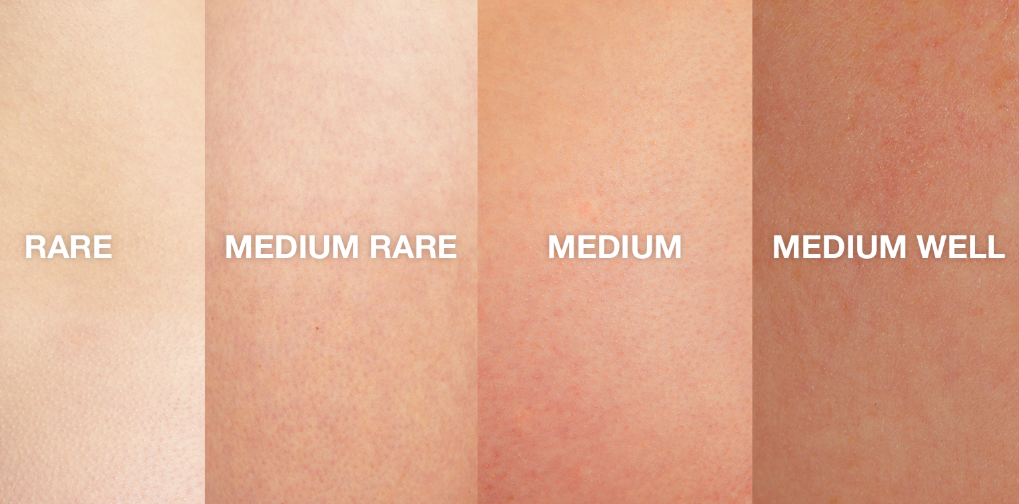
Skin Texture
Skin texture refers to your skin’s surface condition. Good skin texture is soft and smooth, well-hydrated with firm collagen and elastin support. Uneven skin texture is coarse, rough, dull, dry and often sun-damaged. How does your skin feel to the touch if you run your fingers across your face, your hands and your arms?
Ideally, the skin should be soft with a smooth, even texture, but it’s not uncommon to have skin that feels coarse and irregular. Sometimes this is due to specific skin problems such as Rosacea or acne, but it can also be a product of sun damage, aging, or the result of using the wrong skincare products and poor exfoliation. Dry skin can also cause skin texture to feel rough and uneven, especially during the winter months. Uneven skin texture not only feels unpleasant, but it also makes skin look dull because it doesn’t reflect light as well. Also, it makes it hard to apply cosmetics smoothly.

How To Improve Skin Texture?
To keep your skin fresh and health you need to follow certain steps. You can consult with the best dermatologist in Lahore to get the best possbile skin care tips and treatment.
4 Easy Steps to Improve Skin Texture
Drink Water
Improving skin texture can be as simple as staying hydrated throughout the day since that moisture helps to make skin look and feel smoother. Moisturized skin also tends to lessen the appearance of dullness, which is a common symptom of uneven texture.
Exfoliate
Use a Chemical Peel
If you’re not sure about making an appointment for a chemical peel with a dermatologist just yet, try one at home that has the ingredients you need to remove dead skin and exfoliate. This one has pomegranate enzymes that brighten skin as well as hydroxy acids that lift away dead skin cells. Start using this once a week and adjust if necessary.
Start Using Oils
Besides their soothing scent and consistency, oil-based products are ideal for regulating sebum production in the skin – thus making it supple, yet balanced and ultra-smooth. If you require balance or extra moisture, try incorporating face oils into your nightly skincare regimen and watch as you wake up with baby-soft skin.
Uneven Skin Texture
Healthy skin is beautiful skin – that’s a fact, and while most of us long for a luminous, vibrant complexion, we’re often plagued with skin issues that make this goal seem hard to attain. For many reasons, skin texture can become patchy, rough, flaky and bumpy. Uneven skin texture causes the skin to look dull and may be accompanied by enlarged pores. The fact is, while smooth, luminous skin may come naturally to a select few, maintenance is an important and necessary reality for most.
Skin texture and tone can be affected in some ways and by several different issues. A lackluster complexion is often the result of a buildup of dead skin cells in the uppermost layer of the skin. This causes the skin to scatter light instead of evenly reflecting it, resulting in a loss of radiance.

In areas of the face where oil production is heavier, these dead skin cells can congest pores, resulting in comedones (blackheads or whiteheads) and ultimately a bumpy and irregular texture. Sun exposure and aging can also affect texture, as cell turnover slows with age and damage becomes more obvious than ever.
Nutritional Factors That Affect Texture
Silicon is an element that works with calcium to improve the strength and flexibility of the structural system of the body. Calcium is hard and brittle (like chalk), but when silicon combines with calcium and other minerals for bones, nails, hair, and teeth, it adds flexibility to the strength. Western diets tend to be low in silica. The coarse, fibrous parts of the plant containing the most silicon (husks, stems, peelings, cores, etc.) are not part of our diet. They are usually discarded.
Dulse (seaweed) and the herb Horsetail (a vital mineral) are two of the richest sources of organic silicon in the plant kingdom and key nutrients that target the skin, addressing skin texture specifically.
A dulse is a form of seaweed and one of the richest sources of silicon. If you’ve ever examined seaweed washed up on the shore, you probably noticed that it is flexible but tough to tear. This is the major characteristic which silicon imparts to plants and animal tissue – strength with flexibility. Dulse is also rich in iodine, which is important for the proper functioning of the thyroid gland, responsible for healthy hair, skin, and nails and contains many other trace minerals essential for overall good health.





